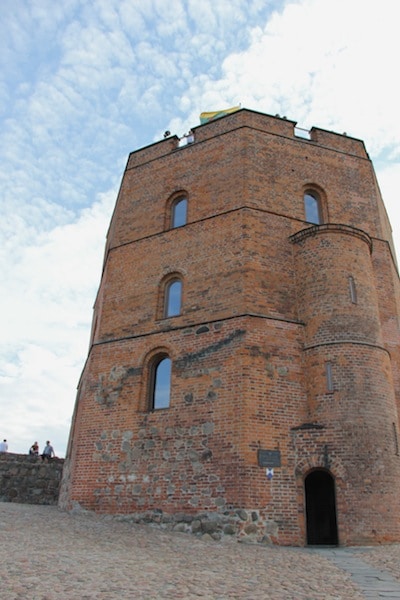So the Soviets? They were kind of jerks. They really sucked. And I mean REALLY sucked. They bulldozed or destroyed what seems like everything they came across, making it seem nothing short of a miracle to find original sights within the former Soviet countries (at least, in the ones we’ve been to); they killed and maimed; they collected countries like an episode of Hoarders; and they just generally behaved like a bunch of A-holes.
Which is perhaps why I loved and was so moved when I accidentally happened upon the third floor of the Gediminas Castle tower in Vilnius, Lithuania, unaware of the awesome history lesson I was about to receive. Gediminas Castle was a bit of a symbol of Vilnius; hailing from the early 1300s, it was damaged during WWII, and wasn’t rebuilt. The best surviving tower still stands high above Vilnius, watching over the city and housing a museum and viewing platform.

I found the museum mostly unimpressive. The third floor, however, is dedicated to the Baltic Way, an independence movement that united Lithuanians, Latvians, and Estonians in their mutual distaste for Soviet occupation of their countries, which lasted from 1944 to 1991. In August, 1989, timed to mark the 50th anniversary of the Molotov-Ribbentrop Pact which secretly carved up Finland, the Baltic States, Poland, and Romania among Nazi Germany and the Soviets, people of the Baltic states joined hands and formed a human chain along the 600-ish km stretching from Gediminas Tower in Vilnius, Lithuania, all the way to Troompea in Tallinn, Estonia, in a peaceful protest of the Soviet Union’s occupation of their countries.
If, like me, you only vaguely recall hearing about the Molotov-Ribbentrop Pact in high school or university history, a bit of background may help. Way back when, during WWII, Mr. Molotov of the USSR (who, not coincidentally, is also the namesake of the not-so-delightful cocktail) and Mr. Ribbentrop of Germany got together and, under the orders of their respective bosses, signed a non-agression pact, which included a secret and oh-so-sinister agreement to divide the states geographically unfortunate enough to be located between Germany and the USSR. The Soviets got the Baltics, invaded, and declared them the lucky winners of a lifetime membership to the USSR.
Fifty years later, the people were getting rather sick of the Soviet tomfoolery (let’s just call it what it was, shall we? Soviet A-holery), and the independence movements of the three countries got together and organized a human chain. Over one million Lithuanians, Latvians, and Estonians joined hands across the three countries to bring their countries’ plights — and the secret and oh-so-sinister aspects of the Molotov-Ribbentrop Pact — to the attention of the world.


I have to admit, I got a bit teary-eyed in that castle tower, staring down at the long ago photographs of the chain people (chain gang?). It reminded me of what popular culture has taught me the 1960s in places like Berkley and San Francisco must have been like, without the LSD and tie-dye: hopeful, bold, and naive in the sense that they really believed that peacefully working together would change the world. And the best part of all? Working together peacefully DID change the world: although the Soviets had a lot to SAY about the act of defiance, they didn’t do anything, and less than a year after the chain, Lithuania became the first of the Baltic countries to declare independence from the USSR. These weren’t radicals, they were just ordinary children and parents and grandparents who’d had enough, and wanted the world to know.
When your heart is warm enough, and you’ve quit slobbering at the togetherness, you can keep climbing to the top of the tower, and you’ll be treated to a panoramic view of Lithuania’s beautiful capital city.



Pingback: Hill of Crosses in Lithuania
Pingback: The A-Holes of History: The Mayans
Pingback: University of Tartu Student Lock-Up
Pingback: Student Prison at the University of Tartu: The A-Holes of History - WanderTooth
I was one of the children in the chain :-)
NO WAY! REALLY? That’s amazing! What do you remember from that – wow, any stories?
Pingback: Attending a Soccer Game in Argentina